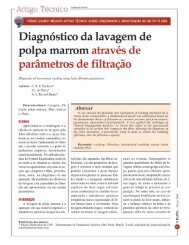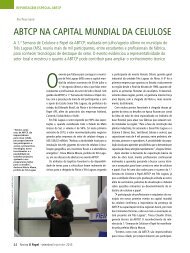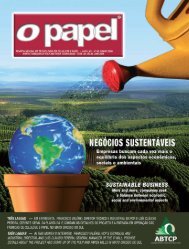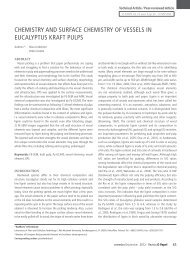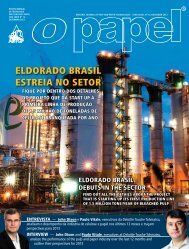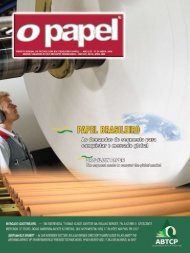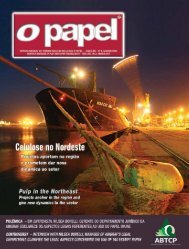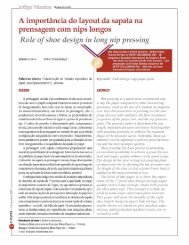You also want an ePaper? Increase the reach of your titles
YUMPU automatically turns print PDFs into web optimized ePapers that Google loves.
Technical Article / Peer-reviewed Article<br />
O PAPEL vol. 73, num. 7, pp. 57 - 65 JUL 2012<br />
The external fibrillation measurements were carried out at<br />
the laboratory of Paper Technology of the Helsinki University<br />
of Technology (now Aalto University). Fines were removed from<br />
samples with a BDDJ apparatus. Microscopy samples from the<br />
R200 fraction were prepared with gelatin solution as a mounting<br />
medium. Images were acquired automatically using a phase<br />
contrast microscope with 10x objective. The images having too<br />
few or too many fibres were removed automatically by a Matlab<br />
program. The number of accepted images was about 100 for<br />
each sample. Another Matlab program was used to detect fibres<br />
and fibrils in the images. The degree of external fibrillation<br />
is calculated as the ratio of fibril area to the fibre area. Based<br />
on this data, a fibrillation index was calculated as a weighted<br />
average (Kurhila, 2005).<br />
The STFI MMS (pulp measurement system) is based on the<br />
detection and measurement of light that is scattered, absorbed and<br />
transmitted by a flowing pulp suspension (Karlsson, Pettersson,<br />
1982). In our case, the KFP (fibril-to-fibre ratio) was evaluated. This is<br />
a relative measurement of the increase in specific surface due to the<br />
presence of fibrils in the pulp. The value is presented as a percentage,<br />
and a KFP value of 100% corresponds to no fibrils in the pulp. If the<br />
value of the KFP is 200%, the specific surface is doubled due to the<br />
presence of fibrils. By removing the fibrils/fines that are not attached<br />
to the fibres, a measurement of the external fibrillation is obtained.<br />
Light microscopy with a phase contrast objective was used.<br />
RESULTS<br />
Refining results<br />
Figure 1 shows the development of WRV for the pulp refined in<br />
different ionic forms. At a given specific energy input, the highest<br />
WRV was obtained for the fibre refined in the Na + -form. The other<br />
two ionic forms (Ca 2+ and H + ) did not differ substantially from each<br />
other. After refining, the pulp refined in the Na + -form was converted<br />
back to the Ca 2+ -form and the WRV was determined. A large part of<br />
the increased swelling was then lost, but at a given specific refining<br />
energy input the WRV was still at a higher level.<br />
Figure 2 shows the °SR number for the pulp refined in the<br />
different ionic forms. At a given specific refining energy input, the<br />
pulp refined in the Na + -form had a much higher °SR number than the<br />
other two ionic forms.<br />
The fibre length measurements showed that the fibre shortening<br />
was somewhat more severe for the pulps refined in the H + -form,<br />
and that the fibres refined in the Ca 2+ -form suffered least from fibre<br />
Rheological measurements<br />
A parallel plate StressTech ® rheometer from Rheologica<br />
Instruments AB (Lund, Sweden) was used for the rheological<br />
measurements. Oscillatory shear with controlled strain was<br />
applied. The sample was held in place by a plastic ring with a<br />
diameter of 50.5 mm around the lower plate. The diameter<br />
of the upper plate was 40.0 mm. In order to prevent slipping,<br />
sandpaper 120 grit was attached to the plates with doublesided<br />
adhesive tape. The gap between the plates was 7.06 mm<br />
and was checked and readjusted before each measurement.<br />
Three samples for each pulp and consistency were studied. All<br />
measurements used 1 Hz frequency and the strain range was from<br />
6*10 -4 to 1. The pulp consistency was determined by drying the<br />
sample after measurements at 80°C overnight. The shear modulus<br />
as a function of strain is retained by small amplitude oscillations<br />
under controlled strain. The shear modulus, G * , was divided into<br />
its real and imaginary parts, G* = G´ + iG”, where G´ is the storage<br />
modulus and G” is the loss modulus. The storage modulus is<br />
independent of the applied strain at low strains and G`0 is defined<br />
as the plateau value of the storage modulus in the linear region<br />
(Horvath, 2006). Above a critical strain, c,<br />
the storage modulus<br />
starts to decrease. The critical strain thus marks the onset of<br />
breakage of the network structure in the fibre suspension (Swerin<br />
et al., 1992) and can be determined from the intersection of the<br />
regions according to Horvath (2006).<br />
Figure 1. The WRV as a function of specific refining energy input for<br />
the pulps in different ionic forms. After refining, the Na + -form pulp<br />
was converted back to Ca 2+ -form and the WRV was again measured<br />
(Na + /Ca 2+ ). The error bars show the coefficient of variation<br />
Figure 2. °SR number as a function of specific refining energy input<br />
for the pulps in different ionic forms<br />
julho/July 2012 - <strong>Revista</strong> O <strong>Papel</strong><br />
59



